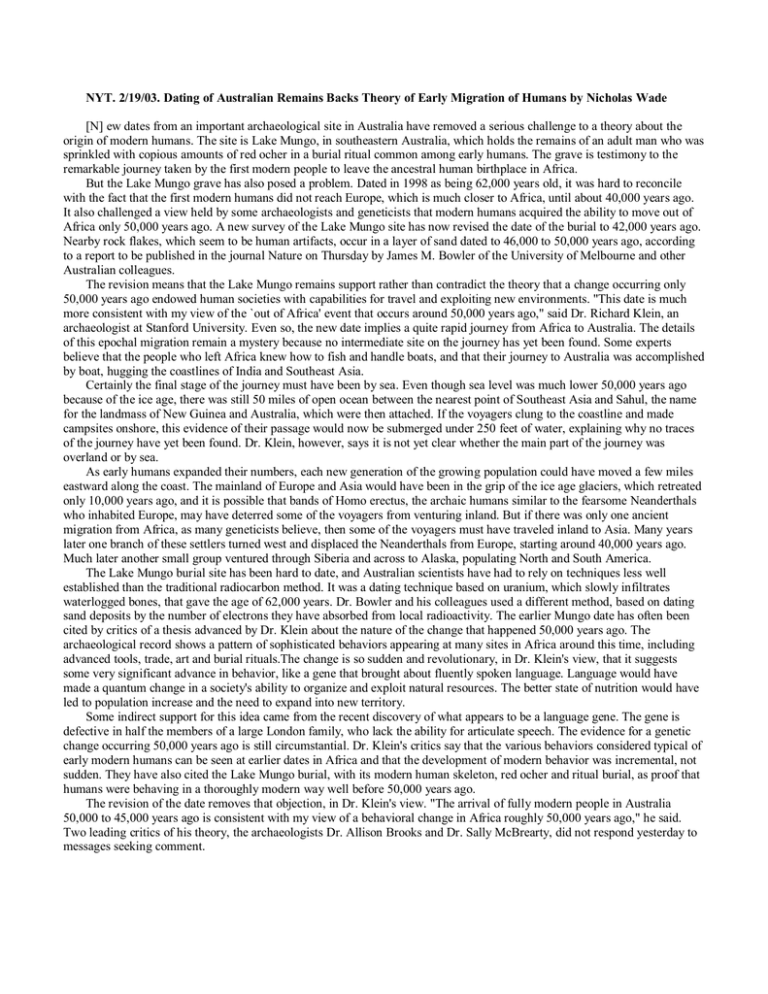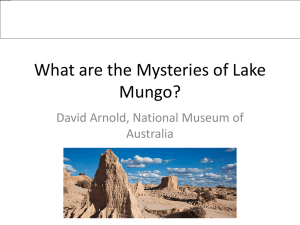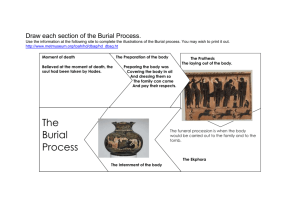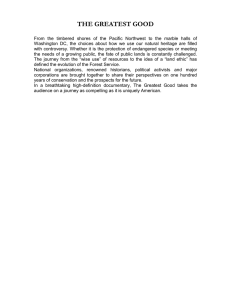Document 14251158
advertisement

NYT. 2/19/03. Dating of Australian Remains Backs Theory of Early Migration of Humans by Nicholas Wade [N] ew dates from an important archaeological site in Australia have removed a serious challenge to a theory about the origin of modern humans. The site is Lake Mungo, in southeastern Australia, which holds the remains of an adult man who was sprinkled with copious amounts of red ocher in a burial ritual common among early humans. The grave is testimony to the remarkable journey taken by the first modern people to leave the ancestral human birthplace in Africa. But the Lake Mungo grave has also posed a problem. Dated in 1998 as being 62,000 years old, it was hard to reconcile with the fact that the first modern humans did not reach Europe, which is much closer to Africa, until about 40,000 years ago. It also challenged a view held by some archaeologists and geneticists that modern humans acquired the ability to move out of Africa only 50,000 years ago. A new survey of the Lake Mungo site has now revised the date of the burial to 42,000 years ago. Nearby rock flakes, which seem to be human artifacts, occur in a layer of sand dated to 46,000 to 50,000 years ago, according to a report to be published in the journal Nature on Thursday by James M. Bowler of the University of Melbourne and other Australian colleagues. The revision means that the Lake Mungo remains support rather than contradict the theory that a change occurring only 50,000 years ago endowed human societies with capabilities for travel and exploiting new environments. "This date is much more consistent with my view of the `out of Africa' event that occurs around 50,000 years ago," said Dr. Richard Klein, an archaeologist at Stanford University. Even so, the new date implies a quite rapid journey from Africa to Australia. The details of this epochal migration remain a mystery because no intermediate site on the journey has yet been found. Some experts believe that the people who left Africa knew how to fish and handle boats, and that their journey to Australia was accomplished by boat, hugging the coastlines of India and Southeast Asia. Certainly the final stage of the journey must have been by sea. Even though sea level was much lower 50,000 years ago because of the ice age, there was still 50 miles of open ocean between the nearest point of Southeast Asia and Sahul, the name for the landmass of New Guinea and Australia, which were then attached. If the voyagers clung to the coastline and made campsites onshore, this evidence of their passage would now be submerged under 250 feet of water, explaining why no traces of the journey have yet been found. Dr. Klein, however, says it is not yet clear whether the main part of the journey was overland or by sea. As early humans expanded their numbers, each new generation of the growing population could have moved a few miles eastward along the coast. The mainland of Europe and Asia would have been in the grip of the ice age glaciers, which retreated only 10,000 years ago, and it is possible that bands of Homo erectus, the archaic humans similar to the fearsome Neanderthals who inhabited Europe, may have deterred some of the voyagers from venturing inland. But if there was only one ancient migration from Africa, as many geneticists believe, then some of the voyagers must have traveled inland to Asia. Many years later one branch of these settlers turned west and displaced the Neanderthals from Europe, starting around 40,000 years ago. Much later another small group ventured through Siberia and across to Alaska, populating North and South America. The Lake Mungo burial site has been hard to date, and Australian scientists have had to rely on techniques less well established than the traditional radiocarbon method. It was a dating technique based on uranium, which slowly infiltrates waterlogged bones, that gave the age of 62,000 years. Dr. Bowler and his colleagues used a different method, based on dating sand deposits by the number of electrons they have absorbed from local radioactivity. The earlier Mungo date has often been cited by critics of a thesis advanced by Dr. Klein about the nature of the change that happened 50,000 years ago. The archaeological record shows a pattern of sophisticated behaviors appearing at many sites in Africa around this time, including advanced tools, trade, art and burial rituals.The change is so sudden and revolutionary, in Dr. Klein's view, that it suggests some very significant advance in behavior, like a gene that brought about fluently spoken language. Language would have made a quantum change in a society's ability to organize and exploit natural resources. The better state of nutrition would have led to population increase and the need to expand into new territory. Some indirect support for this idea came from the recent discovery of what appears to be a language gene. The gene is defective in half the members of a large London family, who lack the ability for articulate speech. The evidence for a genetic change occurring 50,000 years ago is still circumstantial. Dr. Klein's critics say that the various behaviors considered typical of early modern humans can be seen at earlier dates in Africa and that the development of modern behavior was incremental, not sudden. They have also cited the Lake Mungo burial, with its modern human skeleton, red ocher and ritual burial, as proof that humans were behaving in a thoroughly modern way well before 50,000 years ago. The revision of the date removes that objection, in Dr. Klein's view. "The arrival of fully modern people in Australia 50,000 to 45,000 years ago is consistent with my view of a behavioral change in Africa roughly 50,000 years ago," he said. Two leading critics of his theory, the archaeologists Dr. Allison Brooks and Dr. Sally McBrearty, did not respond yesterday to messages seeking comment.




